
"101 Taipei" - Largest Building in the World
Having friends in south Taiwan gave us an excuse to spend Thanksgiving 2007 in Taiwan. We landed in Taipei at night after 20 hours in the air, so we got a hotel room and the next day took the train south. The two biggest cities in Taiwan are Taipei and Kaohsiung. I will tell our story separately for each of these cities, but first here are facts and opinions about Taiwan as a whole
Taiwan: The Country and People
To be “Taiwanese” one's ancestors must have moved to Taiwan before 1949, when the Kuomintang ( KMT) Chinese led by Chiang Kai-shek were swept over to Taiwan by the communists led Mao. Now about 85% of Taiwan's 23 million people are Taiwanese, with most of the remainder being the KMT. Taipei has a population of 2.6 million, and the entire metro area constitutes a fourth of the Taiwan population. The geography of Taiwan is unusually diverse. The mountain range follows the center of the Island all the way from north to south. Snow in the mountain peaks provides for winter skiing that offsets the tropic climate at lower levels. Summer is hot and humid with typhoons. Enough said.
 |
"101 Taipei" - Largest Building in the World |
Many people don't realize the standard of living in Taiwan. With a per capita GDP of $30,000 it ranks 22nd among all countries in terms of GDP per capita, which puts Taiwan ahead of Spain, New Zealand, and all Eastern European countries. Their average income is four times that of China. And yet, like Hong Kong, it is not an official country.
Another sign of their progress is the fact that almost 90% of the residents of Taipei not only have Internet access at home, but broadband (high speed) access. (Of course, it is much less in rural Taiwan.) The country has a strong educational system that supports progressive reform as well as wide use of information technology.
Our your left, the building "101 Taipei," the world's tallest building, is a symbol of their economic success and hopes for growth in the future. It stands as if a king on his throne watching over the city.
Almost all Taiwanese are of Chinese ancestry and although there are several Taiwanese dialects, all speak Chinese as traditional Chinese is spoken in the schools. Supposedly 35% of the people of Taiwan speak English, but we found that most could not carry on a discussion in English, and even fewer could understand what we said in English.
Politics in Taiwan are confusing if not convoluted. Taiwan is still officially a province of China, yet it continually agitates to be recognized as a separate country. During our visit we often saw huge signs that say “UN for Taiwan.” Since the 1990s they have had a democratically elected government. The most powerful party, the KMT, and its affiliated Blue coalition parties seek eventual reunification with China but with considerable control. The Democratic Progressive Party (the DPP) and its party coalition of Green parties promote independence for Taiwan but not wanting the wrath of China, they promote the status quo. The stalemate between Taiwan's Greens and Blues ironically is incapacitating much like the Democrats and Republicans in the USA.
Because of the tension with China, Taiwan does not allow any direct flights from Taiwan to China. When I asked our Taiwanese friends if they saw greater normalization of relations with China, the answer was a quick yes. To support their point, they noted that trade and other interaction with China is already such that at any one time, 10 percent of Taiwan citizens are traveling or living in China. Taiwan has a major election coming up in three months and it is a dead heat between the Greens and Blues.
The USA has for decades poured military aid into Taiwan and sold them lots of military equipment too. Most are grateful to the US for this assistance and often the people look to America for fashion and other cultural leadership. In that regard it is more like the Philippines than Japan, China, or even Thailand.
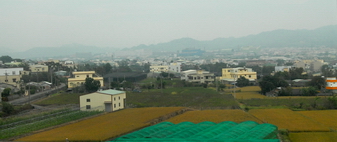 |
Typical village and farms in Central Taiwan as seen from the window of the HSR, one of the worlds fastest trains |
As we watched the terrain stream by on the train, Nancy remarked how neat the fields and irrigation looked. Most of the farm houses were shaped like square match boxes. But they tended to be large and well kept. From the train windows we saw few mountains but lots of well cultivated farms.
Kaohsiung
The train from Taipei to Kaohsiung (pronounced ga-o-shung) is a wonder. It is called the HSR or THSR for Taiwan High Speed Rail and it started running only this year. With departures about every half hour it speeds at 205 miles per hour. With about 4 station stops, you can travel the length of Taiwan in quiet luxury in an hour and a half. Prior to the HSR, passengers required 6 hours to make the same trip. I cannot remember such a quiet, smooth, comfortable train ride. For comfort is beats Germany's ICE train, which runs at about the same speed. And it beats France's TGV, Japan's bullet train, and America's Amtrak, all of which travel more slowly. Furthermore, the HSR is extremely energy efficient. It is a model for transportation that minimizes energy use and greenhouse gases. They claim it is at least 10 times more efficient than driving a car. Taiwan's HSR train project cost nearly $20 billion and was built with private funds.
Kaohsiung immediately felt like all other large Asian cities with a gray haze where the sky and horizon are supposed to be. But we were also impressed by the lively, bright colors of signs and buildings throughout the city. Both Taipei and Kaohsiung look more like the USA than most Asian cities.
Partly what gives Taiwan the look of America is the fact that most of the cars on the streets are relatively large and new. But unlike the US, 95% of the cars are mid-size Toyota and Nissan cars. An SUV is a very rare sight. Also very much unlike America are the motor scooters--millions of them scooting around and among the cars. Additional millions are parked on the sidewalks as you can see by this picture:
 |
Central Taipei near Main Station |
We especially enjoyed looking for scooter families. About every 20 th motor scooter carries a child, and many of these carried two children, one sitting behind the driver, and the other between the legs of the driver. These scooter families exuded family closeness. They also seemed to be saying, “You should save CO2 too?” They can have a comic character too. We saw tiny Taiwanese carrying big dogs and huge packages on their little scooters.
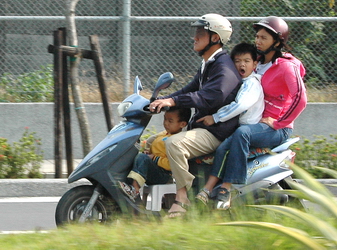
Ela first drove us to her office at the University and then took us across the street to a lovely café on a cliff overlooking the sea. The whole University sits on a steep little mountain on the sea.
Like our university friends in Australia, the university staff at Sun Yat-sen University has the mixed pleasure of sharing the buildings with monkeys. Every once in awhile they will sneak into an office to sit behind a desk, but their main function is to overturn and sort through all of the trash barrels. Funny how similar is the work of monkeys and security officers.
Ela introduced us to Serena, her colleague who also teaches American literature but specializes in eco-criticism. Serena is native Taiwanese but got her PhD at USC in LA. Serena picked out a lovely Chinese-Taiwanese restaurant for our outstanding dinner that first night with them.
Kaohsiung has a population of 1.5 million, but the metro area has over 3 million. As you can see by the photo of downtown, it is a huge city with a very large number of tall buildings. Kaohsiung is the densest and the 2 nd largest city in Taiwan. Kaohsiung will host the 2009 World Games, which is an Olympics for sports (like water skiing and squash) not participating in the main Olympics .
The Port of Kaohsiung is the sixth largest container shipping port in the world, handling twice as many containers as the New York City and New Jersey port area. Despite all of these notorious features, few people have heard of Kaohsiung.
The Kaohsiung-85 building with 85 floors (see photo on right) stands far above the many other tall buildings in town. It houses the Splendor Hotel as well as hundreds of offices. Right at its base rests the giant orange sculpture you see in the photo. Yes, the sculpture is made of the giant containers used for oceanic shipping. Our friend Barbara is pretending to hold up the container.
Chijin Island
Chijin Island is a long, skinny island protecting the Kaohsiung harbor. The northern tip of the Island features a lighthouse high on a little mountain, a colorful Taoist temple, a long beach with grey sand, and a small Taiwanese community that thrives off of selling exotic seafood products. This is the only remaining place for human-pulled rickshaws. A few years ago the Taiwan government banned them from the remaining country because they were seen as old fashioned.
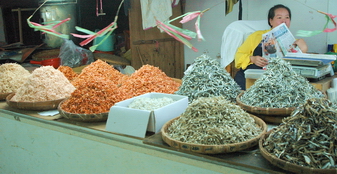
Our last stop on the island was the Tianhou, a Taoist temple that houses many colorful replicas. From there we boarded the ferry to return to the mainland. The ferry takes only about 10 minutes and carries foot passengers as well as passengers on scooters.
Here on the right are scooters disembarking from the boat carrying a family. The little boy has fallen asleep standing up. Some of these children spend many hours every week riding these noisy, smelly, cramped machines. At the age of 10 I would have been thrilled to ride such a beast.
Lotus Pond & Temples
One of the delightful spots to visit in the city is the Lotus Pond and its many temples. The Pond is really a lake surrounded by temples and residential high-rises. It has an area where marvelous lotus flowers bloom, as you can see by the photo on the right. We visited the Pond in late afternoon and already the water began to take on colorful tones.
The Lotus Pond has two huge piers called pavilions, each the size of ocean fishing piers. At the end of each pier sits a colorful pagoda, and along the walkways hang lanterns to light the small statues. The walkway of the Spring Autumn Pavilion pier is stunning with statues and colorful lamps along the entire length of the pier.
The entrance to the Spring Autumn Pavilion (on the left) is guarded by a giant serpent the size of a semi-trailer truck. The other pavilion (below, left) is called the Beiji Xuantian Shang Di Pavilion, which has a gigantic painted statue of the Emperor of the Dark Heaven at the end of the pier. One can see him from a mile away. 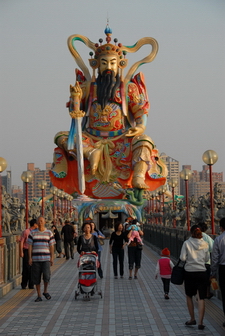
A short walking distance from these wild looking temples and statues is a very large Confucius temple. Within the temple complex is a tea house and restaurant. We had dinner on the water's edge in the dusk. It was memorable and we strongly recommend you include it in your itinerary.
The most recognizable icons of the Lotus Pond are the Dragon-Tiger pagodas (on the right). Here you see them in blazing lights. As you might surmise, they are not ancient edifices, but they add a bit more enchantment to the sacred pond.
The Fo Guang Yuan Monastery
This monastery is outside Kaohsiung and requires a 45 minute drive. The drive is well worth it but allow several hours as it is the largest monastery in Taiwan and perhaps China (outside of Tibet) as well. The buildings sit on 600 hilly acres. About one thousand monks and nuns reside and work in the monastery, and on special occasions many more worship there. The main dining hall has seats and table space for 3,000 people. Not only is the size of the room awe striking, but the building has no inner posts or supports. It was designed, as was the main temple building, to be without internal supports to give a fuller sense of community or oneness. On occasion the hall will be filled with 3,000 monks and lay people as they eat in silence. The atmosphere is worship inducing.
A Buddhist nun served as guide through the entire tour, which lasted about four hours. The first stop was the Shrine to Great Compassion. The center of the shrine is a statue of Avalokitesvara a kind of goddess or exemplar of compassion. The statue and its surroundings created a quiet, peaceful atmosphere.
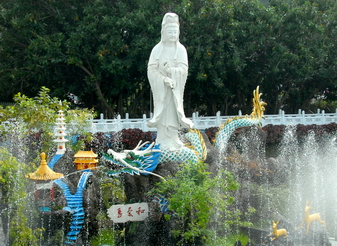 |
Goddess of Great Compassion, Avalokitesvara |
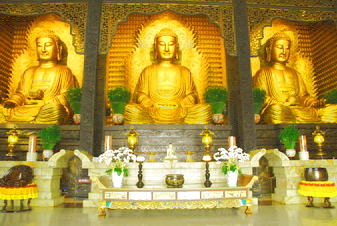
The tallest and most imposing building is a 100+ foot tall statue of Amitabha Buddha (below, left). It stands out on top of a steep hill and can be seen for miles around. By the time we climbed the hill to see it; dusk had stolen most of the light.
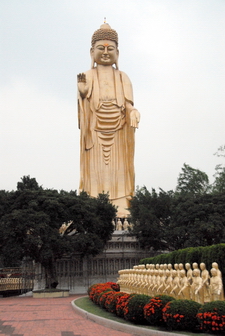
Taipei Thanksgiving
Our first full day in Taipei was Thanksgiving Day. In our hotel, the Caesar Park, some of the staff asked a lot of questions about how we celebrate this day, as they only know about it from television and movies. They were quite anxious to arrange a turkey for us; however the restaurant was charging $60 for a turkey dinner for two.
Last Thanksgiving we spent in Cusco, Peru. As I recall I didn't eat dinner that night because my shingles was so painful. I am very thankful that this year is pain free, other than a minor case of Montezuma's Revenge.
My colleagues from a previous project took us to dinner on the 85 th floor of the famous Taipei 101 building, which is shown at the beginning of this story. The restaurant did not have turkey, but food was authentic Taiwanese-Chinese and tasted unusually good. After dinner they took us to the 89 th floor observation deck. We had great views of the city at night from all 4 directions.
With 101 floors the four year old tower is the tallest building on Earth; however a building now under construction in Dubai will be taller. What people won't do for the “world's tallest” title. The Taipei 101 also has the world's fastest elevator. It soars upward at the ear-popping speed of about 40mph. It drops downward more slowly so that it won't hit bottom so fast if a cable breaks. The
Taipei Sightseeing
Probably the most notorious cultural activity in Taipei is visiting the National Palace Museum . This museum displays thousands of the artifacts brought to Taiwan in 1949 by the Chiang Kai-shek and the KMT. These treasures were a major portion of the priceless artifacts stored in the Forbidden City, the main palace of the last emperor. To this day China considers them stolen and would like to recover them. The collection is remarkable because it so vividly reveals China's evolving culture going back 6,000 years to when they first made tools and weapons with jade stone. The evolution of cooking pottery is traced for thousands of years through the Bronze Age and beyond. Other exhibits trace the evolution of the bowls.
. 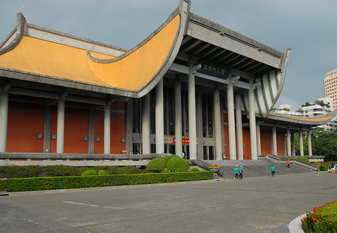
The Sun Yat-Sen Memorial Hall (on the right) is another popular city site. The Hall is the size of a small football stadium and has a variety of exhibition rooms. I took one of the photos from my Grandfather Stafford's collection of photos from 1912 when Sun Yat-Sen became the first president of the new republic. I didn't realize that they already had the photographs along with about 6 or 7 other photos from his collection. Apparently the Shanghai History Museum shared the photos with them after their Stafford exhibition in Shanghai in 2001.
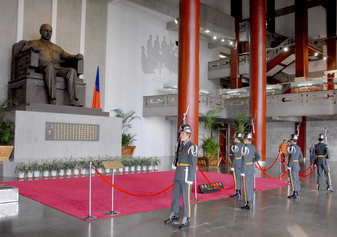
We found a lovely little park called the 2-28 Peace Park tucked among dungy downtown buildings. The park is a memorial to the Taiwanese natives slaughtered by Chiang Kai-shek's KMT on February 28, 1947 as they claimed control of Taiwan after defeat against Chairman Mao. Mostly elderly people quietly sat on park benches watching birds bathing in the fountain, turtles making love on a rock, and young mothers pushing baby strollers. For us the rich green foliage was a delightful change from the winterized plants back home. It was also a reminder of the necessity of harmony between social groups of all races and regions.
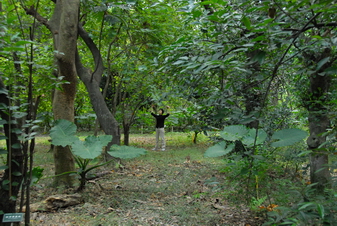
After the exotic life of the Botanical Garden, the temples we visited next seemed to exude less sacredness. First there was the Buddhist temple called Lungshan , but after the Fo Guang Yuan Monastery in Kaohsiung, it felt cramped and primitive.
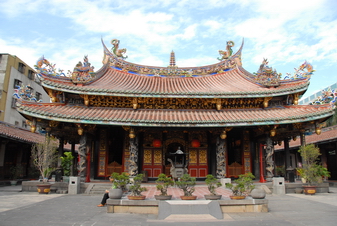
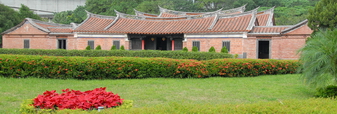 We had been told to be sure to visit the Lin An Tai Historical House (on right) , also called the Old Homestead. This house of a wealthy family for about three centuries, now rests adjacent to a busy freeway but with enough land for a vegetable garden and lily ponds. It gives a rare glimpse of the daily life of earlier generations of Chinese. Their home had some 30 separate rooms, most of which were not connected. Beautiful, dark wood had been used to build exquisite pieces of furniture. While it educates its visitors, it also reminds us of how much we don't know about the actual lifestyles of generations before us.
We had been told to be sure to visit the Lin An Tai Historical House (on right) , also called the Old Homestead. This house of a wealthy family for about three centuries, now rests adjacent to a busy freeway but with enough land for a vegetable garden and lily ponds. It gives a rare glimpse of the daily life of earlier generations of Chinese. Their home had some 30 separate rooms, most of which were not connected. Beautiful, dark wood had been used to build exquisite pieces of furniture. While it educates its visitors, it also reminds us of how much we don't know about the actual lifestyles of generations before us.
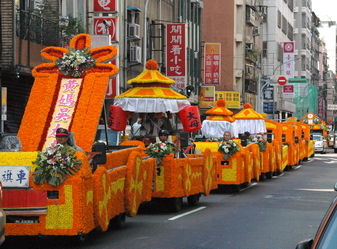
Cultural Boundaries . Like with any society, there are groups and regions considered provincial and less sophisticated. As any country sheds its agrarian preoccupation, the rural classes are seen to be less educated and civilized. Taiwan's region of more negative imagery is the South. But interestingly southerners are also viewed as more hospitable, just like in the US. Also southerners are thought to be less uptight and more spendthrift. And they are more likely to be politically liberal. Appropriate to the label, they are considerably more likely to support the Greens.
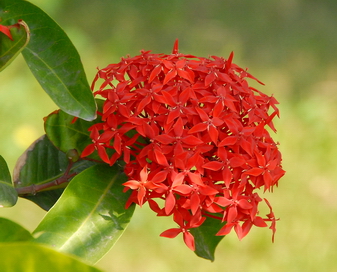 |
Ixora Stricta Roxb, flowers found in Taiwan & SE Asia |
The Taiwanese Character . Like other Asian countries Taiwan's culture emphasizes community rather than individualism. In general family tradition is more important than freedom. What I liked about the Taiwanese is that despite their economic achievements, education, and sophistication, they remain polite, courteous, and very respectful of others. Tourists in any country tend to see less of the negative than would be typical of everyday life in general. However, their courtesy seems genuine and far deeper than “service with a smile.” Like with all Asian culture their respect sometimes feels like ingratiation, but for the more part it comes across as authentic and unselfish. Compared to the United States, it certainly feels more generous and less narcissistic. Caring and concern seems ingrained, and I like that a lot. Nancy and I both definitely recommend a visit to Taiwan.
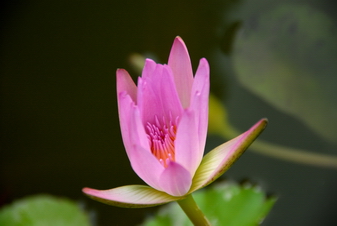 |
Lotus Pond, Kaohsiung, Taiwan |
The American Character . As we re-entered the US in Detroit, we were subjected to 3 passport checks with interrogations and a body search. I have had at least 100 body searches since getting a metal shoulder because it sets off the alarm every time. It is just something I expect and accept, although the American TSA search routine has redundant and frivolous elements; some officers are even comical in their rigidity. The Detroit airport added an extra passport control just in case people switch passports while they are waiting for their luggage. The result is a waiting line a half football field long. It caused me to reflect on how oppressive America has become to travelers coming into the US. No wonder tourism to the US has declined 17% (with a loss of 100 billion in revenue), and immigration is way down too. (Yet at the same time the US does not check every shipping container arriving from foreign countries “because funds have been cut,” even though a container could easily house a nuclear bomb.) After a 20 hour flight I was not feeling joyous and I began to reflect on how America is setting up walls around itself just like gated communities. It's the obsessive security syndrome. If this trend continues, our freedom of movement will erode away. I am thankful that now we can still travel and experience relatively serene and orderly countries like Taiwan.